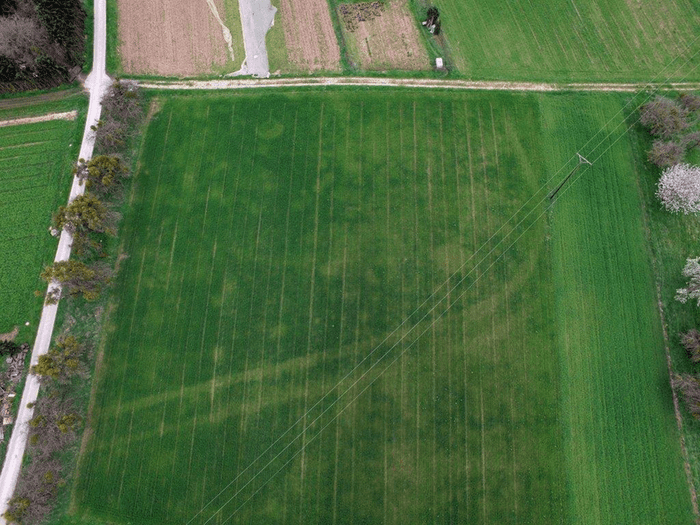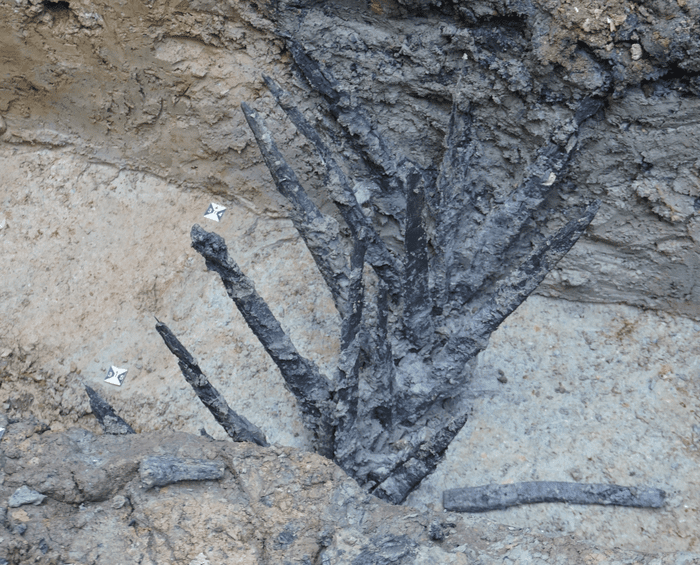An archaeological excavation in Germany has uncovered the first evidence of a Roman defensive technology described by Julius Caesar. The find was made at a site near the town of Bad Ems, where teams also found evidence of two military camps, challenging what we thought we knew about the history of this region.
Bad Ems, in the southwestern German state of Rhineland-Palatinate, has been home for several years to an archaeological teaching dig run by Goethe University. The dig was initiated after a hunter, perched at a high vantage point, spotted a track across a grain field that looked as though it had been made by a gigantic tractor. The different plants growing in different areas of this field suggested that there may have been subterranean structures waiting to be explored. The site was named “Ehrlich”, the German word for “honest”.

An aerial view of Ehrlich showing the clear “tractor line” that turned out to mark the edge of the large Roman camp. Image credit: H.-J. du Roi
Excavations revealed an 8-hectare (20-acre) Roman military camp, which would have had about 40 wooden towers and been home to around 3,000 soldiers. But, there was something odd about it. While it looked as though the camp had been intended as a permanent structure, only one building was ever completed. All those soldiers would have had to sleep in tents, and there was evidence that the camp had been burned down after a few years.
And that wasn’t all. A team of students led by archaeologist Frederic Auth made another important discovery only 2 kilometers (1.2 miles) away, in the soil of the Blöskopf hill. A second camp, much smaller this time, again with evidence it had been burned to the ground.
Photos snapped by Auth and sent to colleague Professor Markus Scholz show what, at first glance, appear to be unassuming pieces of wood, preserved in the damp earth. Upon further study, however, these pieces of wood would turned out to be the first evidence ever found of a defensive military technology described in the writings of Julius Caesar.

With defenses like these, you can see why attackers might have thought twice about targeting a Roman military camp. Image credit: Frederic Auth
Acting like an Ancient Roman version of barbed wire, a structure of sharp wooden spikes like the ones found by Auth’s team would have likely extended around the perimeter of the camp, to deter attackers. In an incredible stroke of luck, this discovery was made on only the second-to-last day of the planned dig, when the excavation was winding down. The team also found a coin minted in 43 CE, helping them to date the structure with more accuracy.
But why had the Romans never finished the larger camp, and why had both sites been burned down?
Before these military sites were fully explored, it had been thought that the Blöskopf hill area was once home to a Roman smelting works. Excavations way back in 1897 found evidence of processed silver ore. Another smelting works is known to have been built very nearby in around 110 CE. But the coin from 43 CE now proves that the defensive stronghold was there much earlier than that.
It’s possible that the remains of these facilities are the result of a failed attempt to mine silver ore. An account by historian Tacitus speaks of an ill-fated mining operation in 47 CE, under Roman governor Curtius Rufus. Perhaps these military camps were built to help protect the hoard of precious metal the Romans were hoping to discover. “To verify this assumption, […] further research is necessary,” explained Professor Scholz in a statement.
Auth’s account of this amazing archaeological story secured him first prize at the 21st Wiesbaden Science Slam earlier this year. So, even if the Romans never managed to strike gold in Bad Ems, at least the tale has a silver lining.
Source Link: Spiky Wooden Defenses Described By Julius Caesar Unearthed For The First Time